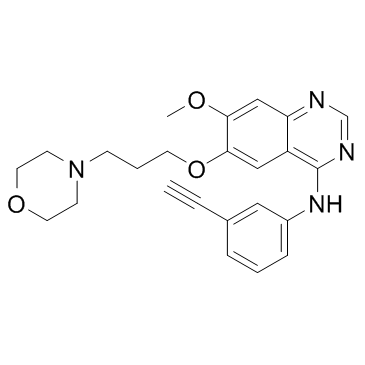| Description |
NRC-2694 is an epidermal growth factor receptor (EGFR) antagonist with anti-cancer and anti-proliferative properties.
|
| Related Catalog |
|
| Target |
EGFR
|
| In Vitro |
NRC-2694 at 80 ng (190 nm) concentrations causes comparable inhibition of EGFR expression[1].
|
| In Vivo |
In toxicity studies, the maximum tolerated dose of NRC-2694 in male and female mice is 2000 mg/kg (po). NRC-2694 (10 mg/kg) regresses the tumor in mice[1].
|
| Cell Assay |
The in vitro invasiveness of H1299 and A549 cells in the presence of various concentrations of NRC compounds (as determined by MTT assay) is assessed using a modified Boyden chamber assay. Cells are treated with these compounds for 48 hr. 1×106 cells are suspended in 600 μL of serum-free medium supplemented with 0.2% BSA and placed in the upper compartment of the transwell chambers coated with matrigel (0.7 mg/mL). The lower compartment of the chamber is filled with 200 μL of serum medium and the cells are allowed to migrate for 24 h. after incubation, the cells are fixed and stained with Hema-3 and quantified. The migrated cells are quantified as percent invasion.
|
| Animal Admin |
Mice: Nude mice are implanted with 2×106 A549 cells in the right hind limb flank. Upon the observance of a tumour (>2 mm), mice are given oral or ip treatments of the test compounds including erlotinib HCl used as positive control. A dose of 100 mg/kg of erlotinib HCl is identified as the base line dose.
|
| References |
[1]. Ramanadham Jyothi Prasad, et al. 6-7,dialkoxy quinazoline derivatives useful for treatment of cancer related disorders. US 8143250 B2
|
